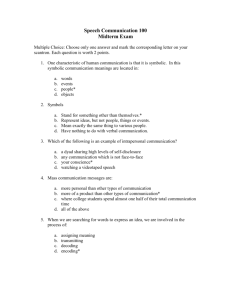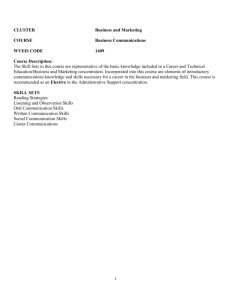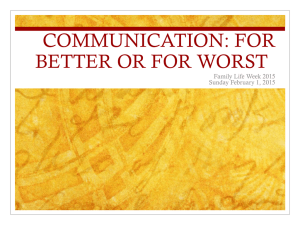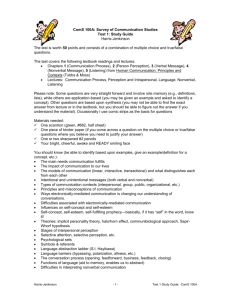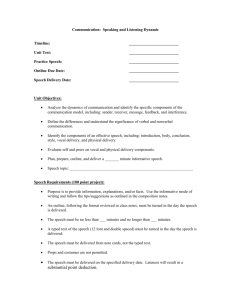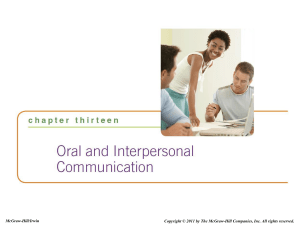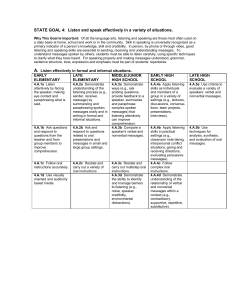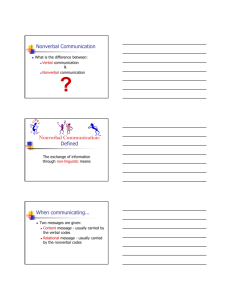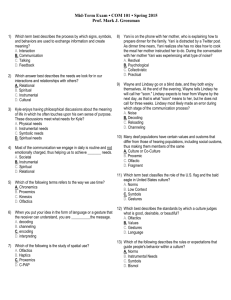Speech Communication 100
advertisement
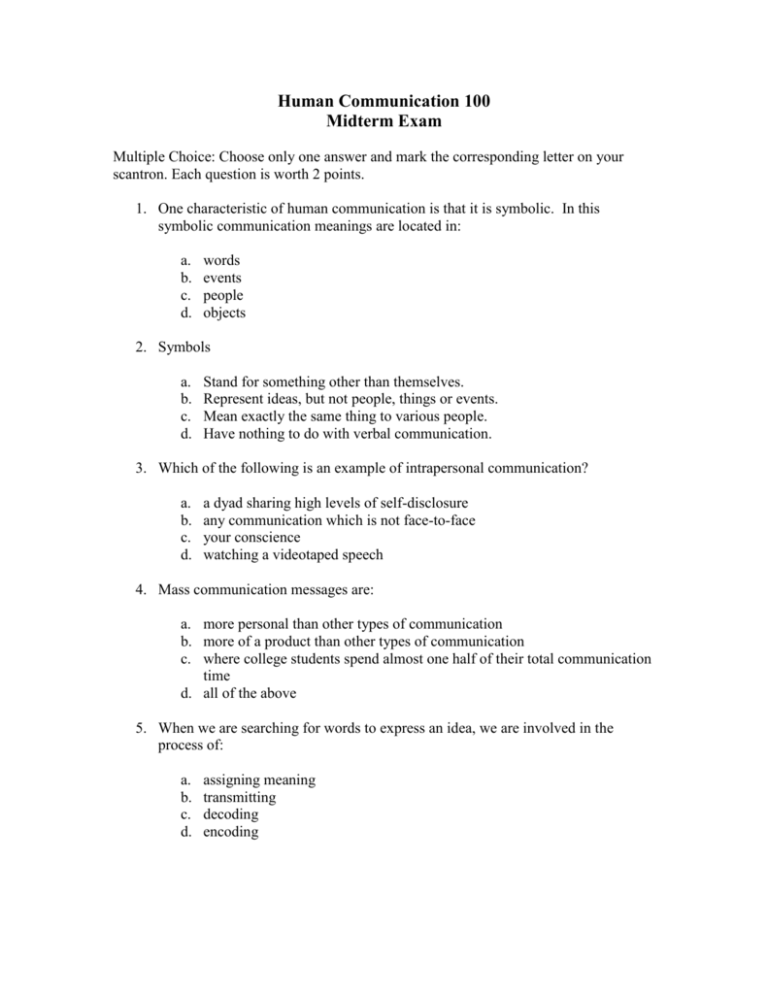
Human Communication 100 Midterm Exam Multiple Choice: Choose only one answer and mark the corresponding letter on your scantron. Each question is worth 2 points. 1. One characteristic of human communication is that it is symbolic. In this symbolic communication meanings are located in: a. b. c. d. words events people objects 2. Symbols a. b. c. d. Stand for something other than themselves. Represent ideas, but not people, things or events. Mean exactly the same thing to various people. Have nothing to do with verbal communication. 3. Which of the following is an example of intrapersonal communication? a. b. c. d. a dyad sharing high levels of self-disclosure any communication which is not face-to-face your conscience watching a videotaped speech 4. Mass communication messages are: a. more personal than other types of communication b. more of a product than other types of communication c. where college students spend almost one half of their total communication time d. all of the above 5. When we are searching for words to express an idea, we are involved in the process of: a. b. c. d. assigning meaning transmitting decoding encoding 6. John is trying to listen to a speech but his headache interferes. He’s experiencing: a. b. c. d. external noise physiological noise psychological noise a distraction not classified as noise 7. As discussed in our text, a person’s self-concept is based upon three main components, they are: a. b. c. d. attitudes, beliefs and values attitudes, beliefs and communication beliefs, communication and feedback none of these 8. William James identifies three components of the self; the material self, the social self, and the __________ self. a. b. c. d. free willed special individualized spiritual 9. Self-expectations are: a. b. c. d. expectations that our family sets for us expectations that our friends set for us expectations that we set for ourselves all of the above combined 10. First impressions are made mostly on the basis of: a. b. c. d. physical characteristics culture and gender experiences and accomplishments interests and opinions 11. A perception check is a skill that is used: a. to see whether your hearing is normal b. to check to make sure that you really understand who a person is c. to test the accuracy of your understanding of a person’s behavior/communication d. to make sure that you have the person right where you want them so they can be persuaded easily 12. Math is your weakest subject. On the first day of college algebra you tell the student next to you, “I bet I’ll get a D in this course”. At the end of the semester you get a D. This result could be an example of: a. b. c. d. self-denial self-disclosure self-fulfilling prophecy self-motivation 13. The perception process requires that we attend to and select stimuli, categorize information and ________________. a. b. c. d. understand the information interpret the information remember the information respond to the information 14. A direct perception check includes all of the following except: a. b. c. d. asking questions asking for clarification relying on observation only paraphrasing the communication 15. Language: a. b. c. d. is symbolic is rule-governed can shape and reflect attitudes all of the above 16. Language use can reflect the speaker’s willingness to take responsibility for his/her statements. Which of the following categories of statements reflects the highest amount of speaker responsibility? a. b. c. d. I statements you statements they statements it statements 17. Which of the following represents the most abstract use of language? a. b. c. d. Women are always causing problems. Sheila is constantly calling the office. Sheila called the lawyer’s office four times. Sheila was on the phone for 30 minutes. 18. Word connotation lets us know that: a. b. c. d. a words’ connotative and denotative meanings are the same words only have one true meaning people’s feelings affect their understanding of word meaning dictionary meanings are the most useful to our understanding 19. Polarization is the tendency to describe things: a. b. c. d. as cold and dark in a denotative way based solely on our past experiences in extremes or opposites 20. Which of the following is an example of sexist language? a. b. c. d. policeman server flight attendant firefighter 21. Which statement below best describes the relationship between listening and hearing? a. b. c. d. Listening and hearing always occur simultaneously. You can listen and not hear. You can hear and not listen. Listening and hearing are the same thing. 22. You are at a noisy wedding reception. Suddenly you notice your name mentioned in the group of people near the refreshment table. Which component of the listening process best describes what occurred in this situation? a. b. c. d. selecting attending understanding remembering 23. What is the relationship between the rate that people speak and the speed at which people listen? a. b. c. d. People can understand speech at rates much greater than people can speak. People can speak at rates much greater than they can understand speech. People speak and listen at approximately the same rate. No predictable relationship exists between speech rate and rate of understanding. 24. Which component of the listening process most makes it a transactional event? a. b. c. d. selecting attending understanding responding 25. Probably the best physical situation for effective listening is: a. b. c. d. sitting in a easy chair with your feet propped up sitting in the dark, where you are forced to concentrate sitting up straight with your eyes on the speaker any of the above – no one situation is better than any other 26. A content paraphrase focuses on: a. b. c. d. the denotative meaning of what a person says how the person feels about what was said whether the person is right or wrong what type of nonverbal cues the person displayed 27. The study of the way people use space is called: a. b. c. d. proxemics paralanguage pixation kinesics 28. The reason you should consider nonverbal messages as clues rather than facts is: a. b. c. d. You need to consider context in determining meaning Communication is ambiguous The history of a relationship can make a difference in interpretation All of the above. 29. Public distance is described in your text as: a. b. c. d. 0 to 18 inches 18 inches to 4 feet 4 feet to 12 feet 12 feet and beyond 30. When politicians give the V sign (index and middle fingers raised to make a “V” for “victory”) rather than speaking after winning an election, they’re using the nonverbal function of: a. b. c. d. repeating substituting complementing accenting 31. When you sit in a classroom seat several for several class periods and then think of it as “my seat”, your are exhibiting: a. b. c. d. a kinesic principle intimate distance emblematic behavior territoriality 32. Which of the following would be labeled as adaptor? a. b. c. d. staring at someone when you’re angry with them winking at a friend tapping your foot on the ground during a presentation standing up to leave a room 33. The clothes you wear: a. b. c. d. reflect your territoriality and popularity can be interpreted as regulators communicate a message about you have little to do with how you will be perceived 34. The sound of your voice is called: a. b. c. d. paralanguage abstract language concrete language kinesics 35. Culture is important to study and understand because: a. b. c. d. Ms. Erdahl’s culture is the best The Disneyland culture must be stopped “Lord of the Rings” is creating a new culture of talking trees Our ability to adapt to one another determines our degree of connectedness to others. True/False Section. Mark “A” if the answer is True, and “B” if the answer is False. Each question is worth 2 points. 36. Because communication is transactional, when communication failure occurs it is fairly simple to figure out which party is to blame. 37. Communication helps satisfy most of our human needs. 38. Meaning rest in people, not in words. 39. Communication is irreversible. 40. Empathy and sympathy are essentially the same. 41. Connotative definitions are less emotional than denotative ones. 42. Language that seems straightforward to some people may seem rude and invasive to others. 43. One valuable type of verbal feedback is the use of questions. 44. Understanding often depends on the ability to organize the information we hear into recognizable form. 45. Nonverbal gestures have precise meaning when compared to verbal communication. 46. People experience the world differently. 47. Vocal communication and verbal communication mean the same thing. 48. Nonverbal behaviors often contribute more to the relational message than to the content message of any given communication. 49. Illustrators substitute for verbal messages. 50. Good communicators never adapt their message because their meaning would be lost.

